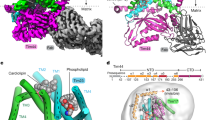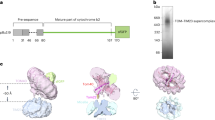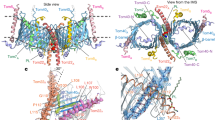Abstract
Mitochondrial preproteins destined for the matrix are translocated by two channel-forming transport machineries, the translocase of the outer membrane and the presequence translocase of the inner membrane. The presequence translocase-associated protein import motor (PAM) contains four essential subunits: the matrix heat shock protein 70 (mtHsp70) and its three cochaperones Mge1, Tim44 and Pam18. Here we report that the PAM contains a fifth essential subunit, Pam16 (encoded by Saccharomyces cerevisiae YJL104W), which is selectively required for preprotein translocation into the matrix, but not for protein insertion into the inner membrane. Pam16 interacts with Pam18 and is needed for the association of Pam18 with the presequence translocase and for formation of a mtHsp70–Tim44 complex. Thus, Pam16 is a newly identified type of motor subunit and is required to promote a functional PAM reaction cycle, thereby driving preprotein import into the matrix.
This is a preview of subscription content, access via your institution
Access options
Subscribe to this journal
Receive 12 print issues and online access
$189.00 per year
only $15.75 per issue
Buy this article
- Purchase on Springer Link
- Instant access to full article PDF
Prices may be subject to local taxes which are calculated during checkout






Similar content being viewed by others
References
Koehler, C.M., Merchant, S. & Schatz, G. How membrane proteins travel across the mitochondrial intermembrane space. Trends Biochem. Sci. 24, 428–432 (1999).
Jensen, R.E. & Johnson, A.E. Opening the door to mitochondrial protein import. Nat. Struct. Biol. 8, 1008–1010 (2001).
Endo, T. & Kohda, D. Functions of outer membrane receptors in mitochondrial protein import. Biochim. Biophys. Acta 1592, 3–14 (2002).
Lithgow, T. Targeting of proteins to mitochondria. FEBS Lett. 476, 22–26 (2000).
Neupert, W. & Brunner, M. The protein import motor of mitochondria. Nat. Rev. Mol. Cell Biol. 3, 555–565 (2002).
Truscott, K.N., Brandner, K. & Pfanner, N. Mechanisms of protein import into mitochondria. Curr. Biol. 13, R326–337 (2003).
Sickmann, A. et al. The proteome of Saccharomyces cerevisiae mitochondria. Proc. Natl. Acad. Sci. USA 100, 13207–13212 (2003).
Truscott, K.N. et al. A presequence- and voltage-sensitive channel of the mitochondrial preprotein translocase formed by Tim23. Nat. Struct. Biol. 8, 1074–1082 (2001).
Geissler, A. et al. The mitochondrial presequence translocase: an essential role of Tim50 in directing preproteins to the import channel. Cell 111, 507–518 (2002).
Yamamoto, H. et al. Tim50 is a subunit of the TIM23 complex that links protein translocation across the outer and inner mitochondrial membranes. Cell 111, 519–528 (2002).
Mokranjac, D. et al. Tim50, a novel component of the TIM23 preprotein translocase of mitochondria. EMBO J. 22, 816–825 (2003).
Martin, J., Mahlke, K. & Pfanner, N. Role of an energized inner membrane in mitochondrial protein import: ΔΨ drives the movement of presequences. J. Biol. Chem. 266, 18051–18057 (1991).
Bauer, M.F., Sirrenberg, C., Neupert, W. & Brunner, M. Role of Tim23 as voltage sensor and presequence receptor in protein import into mitochondria. Cell 87, 33–41 (1996).
Geissler, A. et al. Membrane potential-driven protein import into mitochondria: the sorting sequence of cytochrome b2 modulates the ΔΨ dependence of translocation of the matrix-targeting sequence. Mol. Biol. Cell 11, 3977–3991 (2000).
Huang, S., Ratliff, K.S. & Matouschek, A. Protein unfolding by the mitochondrial membrane potential. Nat. Struct. Biol. 9, 301–307 (2002).
Glick, B.S. Can Hsp70 proteins act as force-generating motors? Cell 80, 11–14 (1995).
Pilon, M. & Schekman, R. Protein translocation: how Hsp70 pulls it off. Cell 97, 679–682 (1999).
Matouschek, A., Pfanner, N. & Voos, W. Protein unfolding by mitochondria: the Hsp70 import motor. EMBO Rep. 1, 404–410 (2000).
Voisine, C. et al. The protein import motor of mitochondria: unfolding and trapping of preproteins are distinct and separable functions of matrix Hsp70. Cell 97, 565–574 (1999).
Liu, Q., D'Silva, P., Walter, W., Marszalek, J. & Craig, E.A. Regulated cycling of mitochondrial Hsp70 at the protein import channel. Science 300, 139–141 (2003).
Bukau, B. & Horwich, A.L. The Hsp70 and Hsp60 chaperone machines. Cell 92, 351–366 (1998).
Matlack, K.E., Misselwitz, B., Plath, K. & Rapoport, T.A. BiP acts as a molecular ratchet during posttranslational transport of prepro-α factor across the ER membrane. Cell 97, 553–564 (1999).
Hartl, F.U. & Hayer-Hartl, M. Molecular chaperones in the cytosol: from nascent chain to folded protein. Science 295, 1852–1858 (2002).
Mayer, M.P., Brehmer, D., Gässler, C.S. & Bukau, B. Hsp70 chaperone machines. Adv. Protein Chem. 59, 1–44 (2002).
Truscott, K.N. et al. A J-protein is an essential subunit of the presequence translocase-associated protein import motor of mitochondria. J. Cell. Biol. 163, 707–713 (2003).
Mokranjac, D., Sichting, M., Neupert, W. & Hell, K. Tim14, a novel key component of the import motor of the TIM23 protein translocase of mitochondria. EMBO J. 22, 4945–4956 (2003).
D'Silva, P.D., Schilke, B., Walter, W., Andrew, A. & Craig, E.A. J protein cochaperone of the mitochondrial inner membrane required for protein import into the mitochondrial matrix. Proc. Natl. Acad. Sci. USA 100, 13839–13844 (2003).
Dekker, P.J.T. et al. The Tim core complex defines the number of mitochondrial translocation contact sites and can hold arrested preproteins in the absence of matrix Hsp70-Tim44. EMBO J. 16, 5408–5419 (1997).
Chacinska, A. et al. Mitochondrial translocation contact sites: separation of dynamic and stabilizing elements in formation of a TOM–TIM-preprotein supercomplex. EMBO J. 22, 5370–5381 (2003).
Meisinger, C. et al. Protein import channel of the outer mitochondrial membrane: a highly stable Tom40-Tom22 core structure differentially interacts with preproteins, small Tom proteins, and import receptors. Mol. Cell. Biol. 21, 2337–2348 (2001).
Jensen, R.E. & Dunn, C.D. Protein import into and across the mitochondrial inner membrane: role of the TIM23 and TIM22 translocons. Biochim. Biophys. Acta 1592, 25–34 (2002).
Bauer, M.F., Hofmann, S., Neupert, W. & Brunner, M. Protein translocation into mitochondria: the role of TIM complexes. Trends Cell. Biol. 10, 25–31 (2000).
Rehling, P., Pfanner, N. & Meisinger, C. Insertion of hydrophobic membrane proteins into the inner mitochondrial membrane—a guided tour. J. Mol. Biol. 326, 639–657 (2003).
Rehling, P. et al. Protein insertion into the mitochondrial inner membrane by a twin-pore translocase. Science 299, 1747–1751 (2003).
Wachter, C., Schatz, G. & Glick, B.S. Role of ATP in the intramitochondrial sorting of cytochrome c1 and the adenine nucleotide translocator. EMBO J. 11, 4787–4794 (1992).
Glick, B.S., Brandt, A., Cunnigham, K., Müller, S. & Hallberg, L.R. Cytochromes c1 and b2 are sorted to the intermembrane space of yeast mitochondria by a stop-transfer mechanism. Cell 69, 809–822 (1992).
Arnold, I., Fölsch, H., Neupert, W. & Stuart, R.A. Two distinct and independent mitochondrial targeting signals function in the sorting of an inner membrane protein, cytochrome c1 . J. Biol. Chem. 273, 1469–1476 (1998).
Gärtner, F. et al. Mitochondrial import of subunit Va of cytochrome c oxidase characterized with yeast mutants: independence from receptors, but requirement for matrix hsp70 translocase function. J. Biol. Chem. 270, 3788–3795 (1995).
Nunnari, J., Fox, T.D. & Walter, P. A mitochondrial protease with two catalytic subunits of nonoverlapping specificities. Science 262, 1997–2004 (1993).
Gakh, O., Cavadini, P. & Isaya, G. Mitochondrial processing peptidases. Biochim. Biophys. Acta 1592, 63–77 (2002).
Rassow, J. et al. Mitochondrial protein import: biochemical and genetic evidence for interaction of matrix hsp70 and the inner membrane protein MIM44. J. Cell Biol. 127, 1547–1556 (1994).
Voos, W. et al. Differential requirement for the mitochondrial Hsp70–Tim44 complex in unfolding and translocation of preproteins. EMBO J. 15, 2668–2677 (1996).
Schneider, H.C., Westermann, B., Neupert, W. & Brunner, M. The nucleotide exchange factor MGE exerts a key function in the ATP-dependent cycle of mt-Hsp70-Tim44 interaction driving mitochondrial protein import. EMBO J. 15, 5796–5803 (1996).
Schwarz, E., Seytter, T., Guiard, B. & Neupert, W. Targeting of cytochrome b2 into the mitochondrial intermembrane space: specific recognition of the sorting signal. EMBO J. 12, 2295–2302 (1993).
Bömer, U. et al. Separation of structural and dynamic functions of the mitochondrial translocase: Tim44 is crucial for the inner membrane import sites in translocation of tightly folded domains, but not of loosely folded preproteins. EMBO J. 17, 4226–4237 (1998).
Becker, S., Gehrsitz, A., Bork, P., Buchner, S. & Buchner, E. The black-pearl gene of Drosophila defines a novel conserved protein family and is required for larval growth and survival. Gene 262, 15–22 (2001).
Jubinsky, P.T. et al. Identification and characterization of Magmas, a novel mitochondria-associated protein involved in granulocyte-macrophage colony-stimulating factor signal transduction. Exp. Hematol. 29, 1392–1402 (2001).
Gambill, B.D. et al. A dual role for mitochondrial heat shock protein 70 in membrane translocation of preproteins. J. Cell Biol. 123, 109–117 (1993).
Kozany, C., Mokranjac, D., Sichting, M., Neupert, W. & Hell, K. The J domain–related cochaperone Tim16 is a constituent of the mitochondrial TIM23 preprotein translocase. Nat. Struct. Mol. Biol. 11, 234–241 (2004).
Sikorski, R.S. & Hieter, P. A system of shuttle vectors and yeast host strains designed for efficient manipulation of DNA in Saccharomyces cerevisiae. Genetics 122, 19–27 (1989).
Ryan, M.T., Voos, W. & Pfanner, N. Assaying protein import into mitochondria. Methods Cell Biol. 65, 189–215 (2001).
Acknowledgements
We thank R. Jensen for antiserum against Tim17, S. Rospert for antiserum against Pam18 and I. Perschil, N. Zufall and H. Müller for expert technical assistance. This work was supported by the Deutsche Forschungsgemeinschaft, Sonderforschungsbereich 388, Max Planck Research Award, Bundesministerium für Bildung und Forschung, Nationales Genomforschungsnetz, and the Fonds der Chemischen Industrie. M.L. is a recipient of a postdoctoral fellowship from the Wenner-Gren foundations. Work in the laboratory of M.G.C. was supported by grant GM 57017 from the US National Institutes of Health.
Author information
Authors and Affiliations
Corresponding authors
Ethics declarations
Competing interests
The authors declare no competing financial interests.
Rights and permissions
About this article
Cite this article
Frazier, A., Dudek, J., Guiard, B. et al. Pam16 has an essential role in the mitochondrial protein import motor. Nat Struct Mol Biol 11, 226–233 (2004). https://doi.org/10.1038/nsmb735
Received:
Accepted:
Published:
Issue Date:
DOI: https://doi.org/10.1038/nsmb735
This article is cited by
-
The mitochondrial Hsp70 controls the assembly of the F1FO-ATP synthase
Nature Communications (2023)
-
Protein import motor complex reacts to mitochondrial misfolding by reducing protein import and activating mitophagy
Nature Communications (2022)
-
J-like protein family of Arabidopsis thaliana: the enigmatic cousins of J-domain proteins
Plant Cell Reports (2022)
-
Mapping protein interactions in the active TOM-TIM23 supercomplex
Nature Communications (2021)
-
Expansion of the evolutionarily conserved network of J-domain proteins in the Arabidopsis mitochondrial import complex
Plant Molecular Biology (2021)



